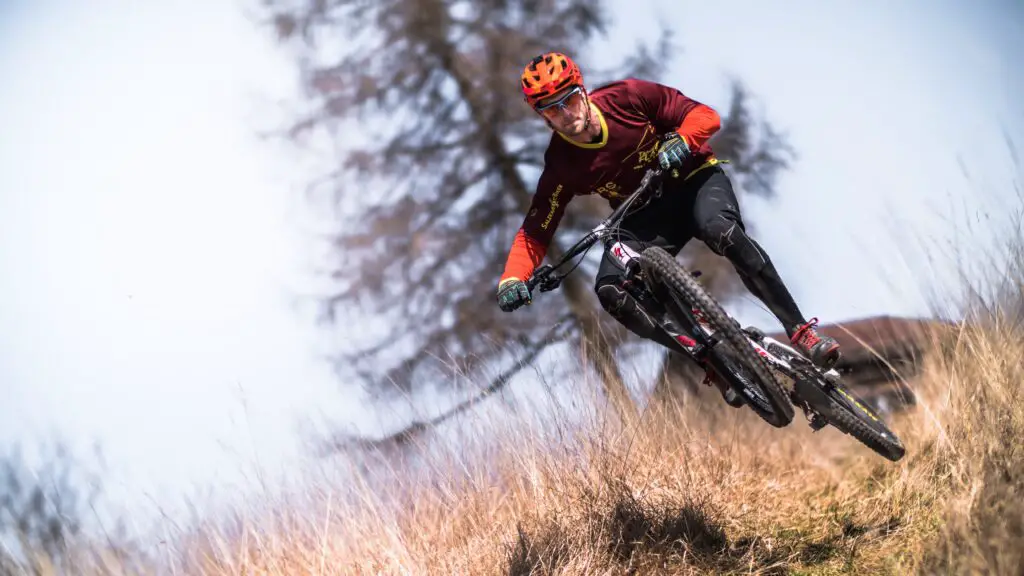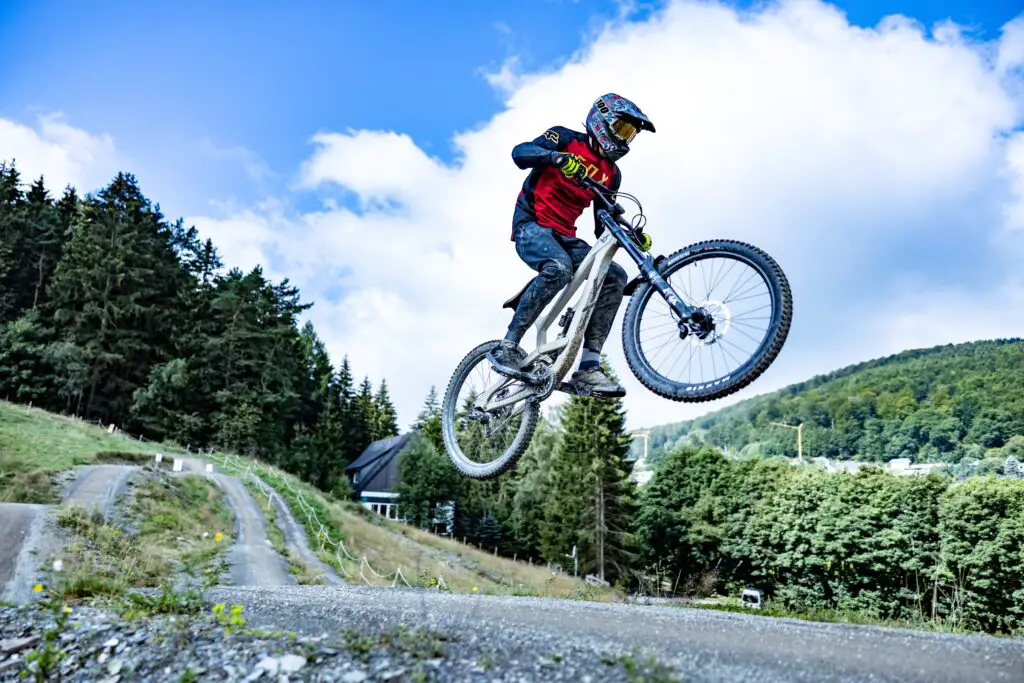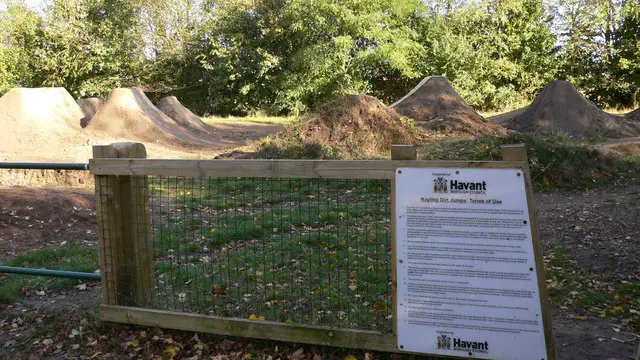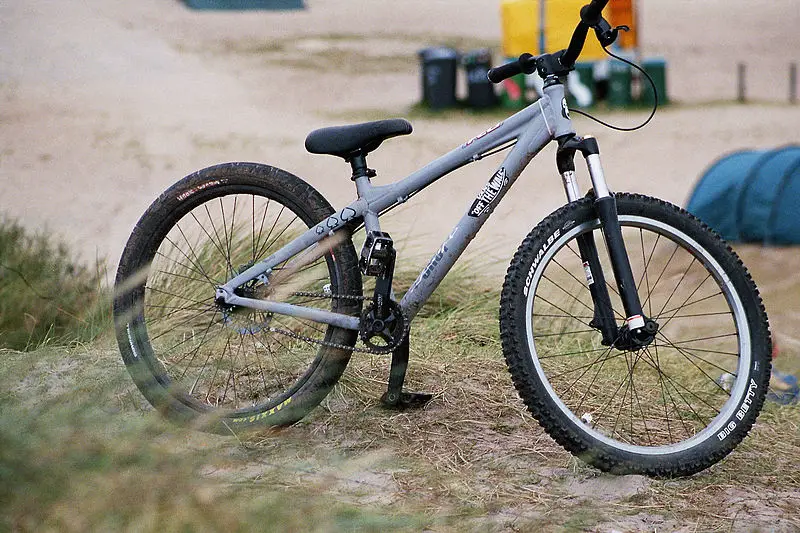Enduro bikes are versatile full suspension mountain bikes that are capable of tackling a range of features, but are they any good for jumping?
Not every jump is built the same. Here we’ll look at scenarios where an enduro bike is the ideal jumping machine, as well as those jumps you’d be best steering clear of on an enduro.
Here’s what you need to know about Jumping on an Enduro Bike:
Enduro bikes are designed to tackle jumps typically encountered on trails. With a suitably long run-up allowing sufficient speed to be generated, these jumps will be no problem for an enduro bike. They aren’t well suited to dirt jumps as they lose energy through compression on steep take-offs.
Table of Contents

What Makes an Enduro Bike Good/Bad for Jumping
When considering whether or not an enduro bike is good for jumping, we first need to specify which sort of jump we’re referring to.
There are two main types of jumps in mountain biking: those that are part of a typical trail ride, and those found on a dirt jump track.
There are a number of differences between the two types of jump that drastically alters the type of bike best suited to each.
Let’s take a look at each type of MTB jump individually and evaluate how suitable enduro bikes are for each type.
Can an Enduro Bike be Used for ‘Trail’ Jumps?
I’ve used the generic term ‘trail jumps’ here to capture the type of jump you’d typically encounter riding on a trail, which could be anything from the first small tabletop you hit as a novice through to the massive jumps in pro downhill runs.
That’s because these jumps are in essence pretty similar, with the exception of their size which gradually increases from a casual trail ride through to jumps in the descent sections of an enduro track, to the biggest jumps found in DH racing.
Whilst coming in many different shapes and sizes, these ‘trail’ type jumps are found on the downhill sections of a trail to give the rider plenty of speed, and typically the face of the jump (or take-off) isn’t crazy steep.
Certainly not as steep as a dirt jump, as we’ll see in a moment.
This is a great example of what a trail-type jump would look like:

The less-steep face of this type of jump means the rider travels horizontally more than vertically after the take-off, and lands whilst preserving most of their forward momentum.
The landings on this type of jump vary considerably, so a sturdy full suspension bike with a decent amount of travel is usually preferred to ensure a smooth landing.
‘Sturdy full suspension bike with a decent amount of travel’ is pretty much the definition of an enduro bike, so they’re ideal for this type of jump.
Whilst enduro bikes are relatively heavy as far as mountain bikes go, that’s not usually an issue for jumping trails. A well-designed trail will have a sufficiently long and steep run-up that allows enough speed to be generated to clear the jump.
Can an Enduro Bike be Used for Dirt Jumps?
Dirt jumps are entirely different from those encountered on trails.
First off, the only feature of a dirt jump track is… you guessed it, dirt jumps. There are no rock gardens, drop-offs, climbs, etc. Just jump after jump that flow into one another.
The jumps themselves are steep. Much steeper than the ones typically found on trails. Here’s an example of what a dirt jump looks like:

The much steeper face of dirt jumps means that the rider is propelled vertically more than horizontally after take-off. Speed is then maintained by hitting the steep landing, giving enough momentum to clear the next jump.
Enduro bikes are not suited to this type of jump for a number of reasons.
The main reason is that they have rear suspension, as well as much more travel on the forks than a dirt jumper.
Dirt jump bikes are like beefed-up BMXs with front suspension, typically with 80mm – 100mm of travel in the forks, compared with the 140mm – 180mm travel front and rear on an enduro bike.

All this suspension causes problems for an enduro bike when hitting steep dirt jumps. As the bike hits the jump, the suspension compresses and takes a lot of momentum out of the bike.
The energy wasted in compressing the suspension of an enduro bike would instead be used to propel the rider and the bike up the face of the jump if riding with a dirt jumper.
Another drawback is that enduro bikes are heavy. An enduro bike will normally weigh in the 30-35 lbs region, whilst a dirt jumper weighs between 22 – 26 lbs.
More weight in a steep dirt jump means less time in the air to line up for a smooth landing.
All this additional weight combined with the loss of energy due to compression of the suspension on an enduro bike makes them a poor choice for dirt jumps.
That’s not to say it’s impossible to ride a dirt jump track on an enduro bike, but it’s much harder and should only be attempted by experienced riders who are very comfortable with their bikes.
(The weight and suspension setup of an enduro bike also has an effect on its climbing ability. If you want to understand more about how well an enduro bike will climb, check out this article we wrote)
How to Make an Enduro Bike Better for Dirt Jumping
If you really want to ride a dirt jump track but only have an enduro bike available to you, there are a couple of things you can do to make it perform a little better.
First of all, firm up both the front and rear suspension. Ideally, lock out the rear suspension if you can. This will help reduce the amount of energy wasted through unwanted compression of the shock.
Secondly, if you want to go a step further try installing lighter rims and/or tires. Wheels make up a significant portion of a bike’s total weight.
Replacing a heavy-duty set of enduro wheels, or even just tires will make your bike that much lighter and easier to get over the dirt jump track.
